2006 CHEVROLET COLORADO child seat
[x] Cancel search: child seatPage 82 of 434

If your vehicle does not have a rear seat that will
accommodate a rear-facing child restraint, never put a
child in a rear-facing child restraint in the right front
passenger seat the unless passenger airbag status
indicator shows off. Never put a rear facing child
restraint in the right front passenger seat unless the
airbag is off. Here is why:
{CAUTION:
A child in a rear-facing child restraint can be
seriously injured or killed if the right front
passenger’s airbag in�ates. This is because the
back of the rear-facing child restraint would be
very close to the in�ating airbag. Be sure the
airbag is off before using a rear-facing child
restraint in the right front seat position.
Even though the passenger sensing system is
designed to turn off the passenger’s frontal
airbag if the system detects a rear-facing child
restraint, no system is fail-safe, and no one can
guarantee that an airbag will not deploy under
some unusual circumstance, even though it is
turned off. We recommend that rear-facing child
restraints be transported in vehicles with a rear
seat that will accommodate a rear-facing child
restraint, whenever possible.
If you need to secure a forward-facing child
restraint in the right front seat, always move
the front passenger seat as far back as it will
go. It is better to secure the child restraint in
a rear seat.
1-76
Page 83 of 434

The passenger sensing system is designed to turn off
the right front passenger’s frontal airbag if:
the right front passenger seat is unoccupied
the system determines that an infant is present in
a rear-facing infant seat
the system determines that a small child is present
in a forward-facing child restraint
the system determines that a small child is present
in a booster seat
a right front passenger takes his/her weight off of
the seat for a period of time
the right front passenger seat is occupied by a
smaller person, such as a child who has outgrown
child restraints
or if there is a critical problem with the airbag
system or the passenger sensing system
When the passenger’s frontal airbag has been turned
off by the passenger sensing system, the off indicator
on the instrument panel will light and stay lit to
remind you that the airbag is off.
If a child restraint has been installed and the on
indicator is lit, turn the vehicle off. Remove the child
restraint from the vehicle and reinstall the child restraint
following the child restraint manufacturer’s directions
and refer toSecuring a Child Restraint in the Right
Front Seat Position on page 1-61.If after reinstalling the child restraint and restarting the
vehicle, the on indicator is still lit, check to make
sure that the vehicle’s seatback is not pressing the child
restraint into the seat cushion. If this happens, slightly
recline the vehicle’s seatback and adjust the seat
cushion if possible. Also make sure the child restraint
is not trapped under the vehicle head restraint. If
this happens, adjust the head restraint.
If the on indicator is still lit, secure the child in the child
restraint in a rear seat position in the vehicle if one
is available and check with your dealer.
The passenger sensing system is designed to enable
(may in�ate) the right front passenger’s frontal airbag
anytime the system senses that a person of adult size
is sitting properly in the right front passenger’s seat.
When the passenger sensing system has allowed the
airbag to be enabled, the on indicator will light and stay
lit to remind you that the airbag is active.
For some children who have outgrown child restraints
and for very small adults, the passenger sensing system
may or may not turn off the right front passenger’s
frontal airbag, depending upon the person’s seating
posture and body build. Everyone in your vehicle who
has outgrown child restraints should wear a safety
belt properly — whether or not there is an airbag for
that person.
1-77
Page 161 of 434
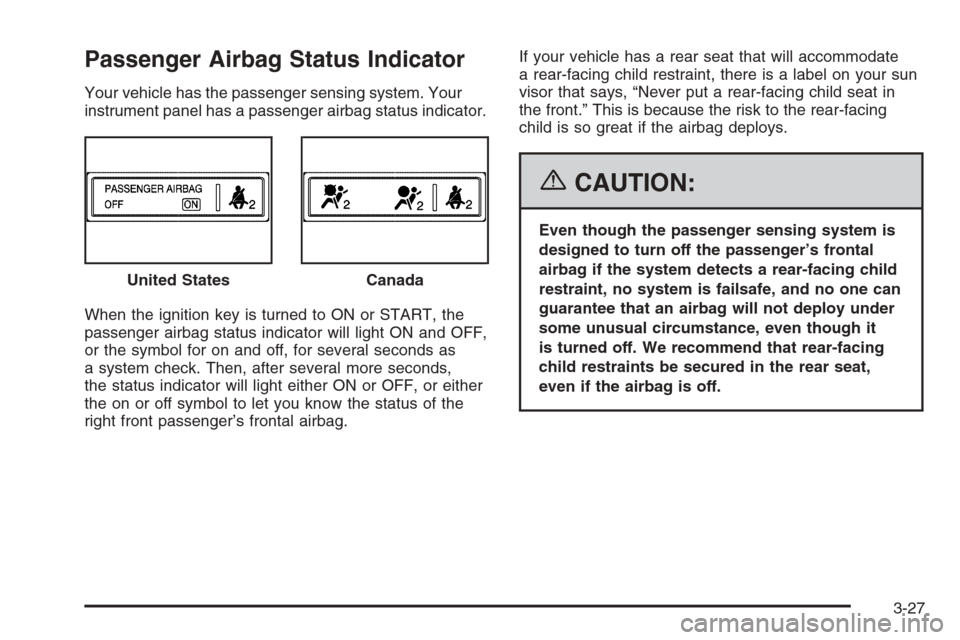
Passenger Airbag Status Indicator
Your vehicle has the passenger sensing system. Your
instrument panel has a passenger airbag status indicator.
When the ignition key is turned to ON or START, the
passenger airbag status indicator will light ON and OFF,
or the symbol for on and off, for several seconds as
a system check. Then, after several more seconds,
the status indicator will light either ON or OFF, or either
the on or off symbol to let you know the status of the
right front passenger’s frontal airbag.If your vehicle has a rear seat that will accommodate
a rear-facing child restraint, there is a label on your sun
visor that says, “Never put a rear-facing child seat in
the front.” This is because the risk to the rear-facing
child is so great if the airbag deploys.
{CAUTION:
Even though the passenger sensing system is
designed to turn off the passenger’s frontal
airbag if the system detects a rear-facing child
restraint, no system is failsafe, and no one can
guarantee that an airbag will not deploy under
some unusual circumstance, even though it
is turned off. We recommend that rear-facing
child restraints be secured in the rear seat,
even if the airbag is off. United States
Canada
3-27
Page 162 of 434
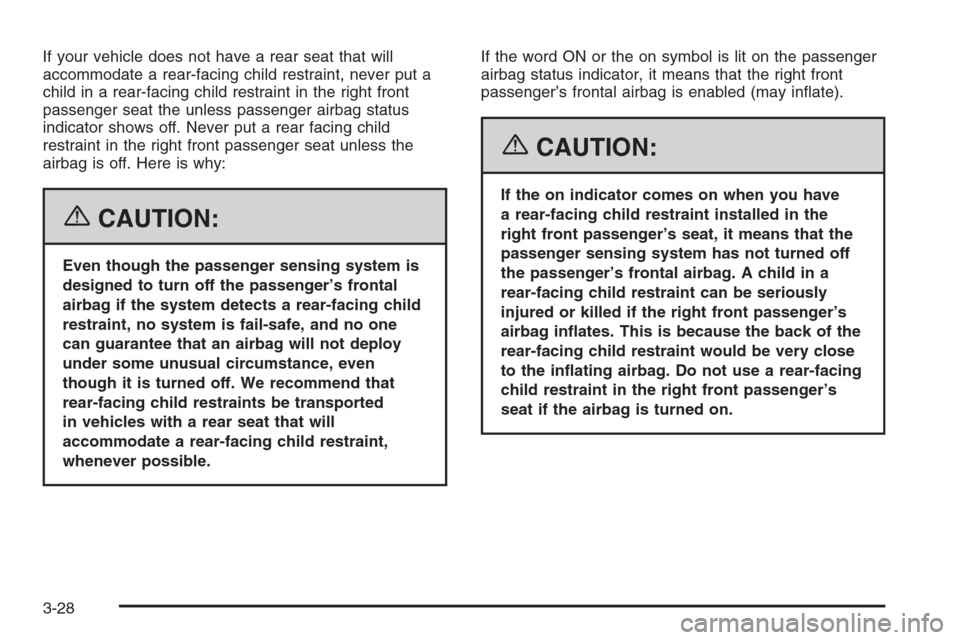
If your vehicle does not have a rear seat that will
accommodate a rear-facing child restraint, never put a
child in a rear-facing child restraint in the right front
passenger seat the unless passenger airbag status
indicator shows off. Never put a rear facing child
restraint in the right front passenger seat unless the
airbag is off. Here is why:
{CAUTION:
Even though the passenger sensing system is
designed to turn off the passenger’s frontal
airbag if the system detects a rear-facing child
restraint, no system is fail-safe, and no one
can guarantee that an airbag will not deploy
under some unusual circumstance, even
though it is turned off. We recommend that
rear-facing child restraints be transported
in vehicles with a rear seat that will
accommodate a rear-facing child restraint,
whenever possible.If the word ON or the on symbol is lit on the passenger
airbag status indicator, it means that the right front
passenger’s frontal airbag is enabled (may in�ate).
{CAUTION:
If the on indicator comes on when you have
a rear-facing child restraint installed in the
right front passenger’s seat, it means that the
passenger sensing system has not turned off
the passenger’s frontal airbag. A child in a
rear-facing child restraint can be seriously
injured or killed if the right front passenger’s
airbag in�ates. This is because the back of the
rear-facing child restraint would be very close
to the in�ating airbag. Do not use a rear-facing
child restraint in the right front passenger’s
seat if the airbag is turned on.
3-28
Page 260 of 434

Your dealer can help you with this. Be sure to spread out
your load equally on both sides of the centerline.
Never exceed the GVWR for your vehicle, or the GAWR
for either the front or rear axle.
If you do have a heavy load, you should spread it out.
Similar appearing vehicles may have different GVWRs
and capacity weights. Please note your vehicle’s
Certi�cation/Tire label or consult your dealer for
additional details.
{CAUTION:
Do not load your vehicle any heavier than the
Gross Vehicle Weight Rating (GVWR), or either
the maximum front or rear Gross Axle Weight
Rating (GAWR). If you do, parts on your vehicle
can break, and it can change the way your
vehicle handles. These could cause you to
lose control and crash. Also, overloading can
shorten the life of your vehicle.
Using heavier suspension components to get added
durability might not change your weight ratings. Ask
your dealer to help you load your vehicle the right way.Notice:Overloading your vehicle may cause
damage. Repairs would not be covered by your
warranty. Do not overload your vehicle.
If you put things inside your vehicle — like suitcases,
tools, packages, or anything else — they will go as fast
as the vehicle goes. If you have to stop or turn quickly,
or if there is a crash, they will keep going.
{CAUTION:
Things you put inside your vehicle can strike
and injure people in a sudden stop or turn, or
in a crash.
Put things in the cargo area of your
vehicle. Try to spread the weight evenly.
Never stack heavier things, like suitcases,
inside the vehicle so that some of them
are above the tops of the seats.
Do not leave an unsecured child restraint
in your vehicle.
When you carry something inside the
vehicle, secure it whenever you can.
Do not leave a seat folded down unless
you need to.
4-48
Page 423 of 434
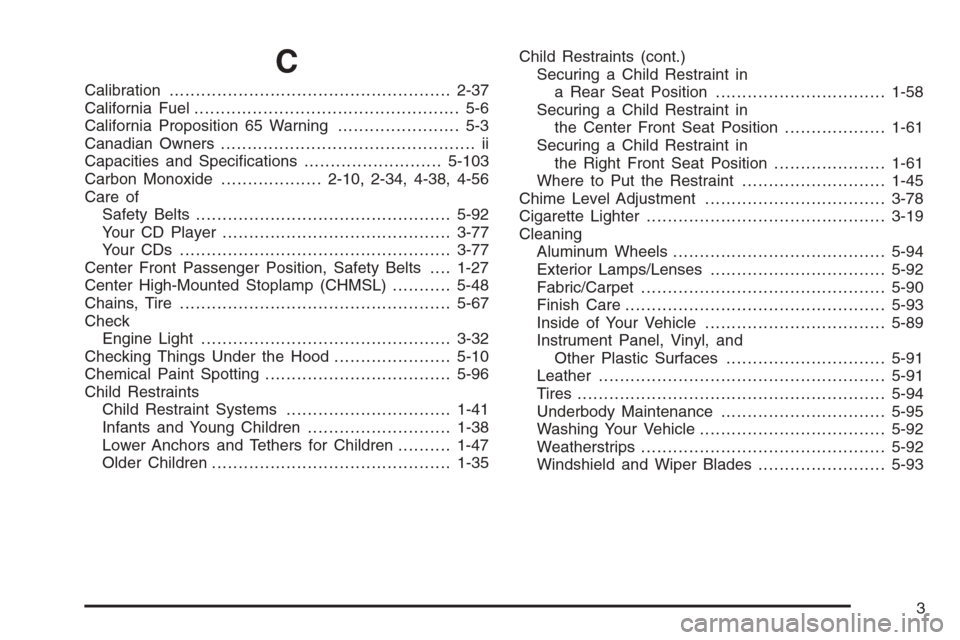
C
Calibration.....................................................2-37
California Fuel.................................................. 5-6
California Proposition 65 Warning....................... 5-3
Canadian Owners................................................ ii
Capacities and Speci�cations..........................5-103
Carbon Monoxide...................2-10, 2-34, 4-38, 4-56
Care of
Safety Belts................................................5-92
Your CD Player...........................................3-77
Your CDs ...................................................3-77
Center Front Passenger Position, Safety Belts....1-27
Center High-Mounted Stoplamp (CHMSL)...........5-48
Chains, Tire...................................................5-67
Check
Engine Light...............................................3-32
Checking Things Under the Hood......................5-10
Chemical Paint Spotting...................................5-96
Child Restraints
Child Restraint Systems...............................1-41
Infants and Young Children...........................1-38
Lower Anchors and Tethers for Children..........1-47
Older Children.............................................1-35Child Restraints (cont.)
Securing a Child Restraint in
a Rear Seat Position................................1-58
Securing a Child Restraint in
the Center Front Seat Position...................1-61
Securing a Child Restraint in
the Right Front Seat Position.....................1-61
Where to Put the Restraint...........................1-45
Chime Level Adjustment..................................3-78
Cigarette Lighter.............................................3-19
Cleaning
Aluminum Wheels........................................5-94
Exterior Lamps/Lenses.................................5-92
Fabric/Carpet..............................................5-90
Finish Care.................................................5-93
Inside of Your Vehicle..................................5-89
Instrument Panel, Vinyl, and
Other Plastic Surfaces..............................5-91
Leather......................................................5-91
Tires..........................................................5-94
Underbody Maintenance...............................5-95
Washing Your Vehicle...................................5-92
Weatherstrips..............................................5-92
Windshield and Wiper Blades........................5-93
3
Page 427 of 434
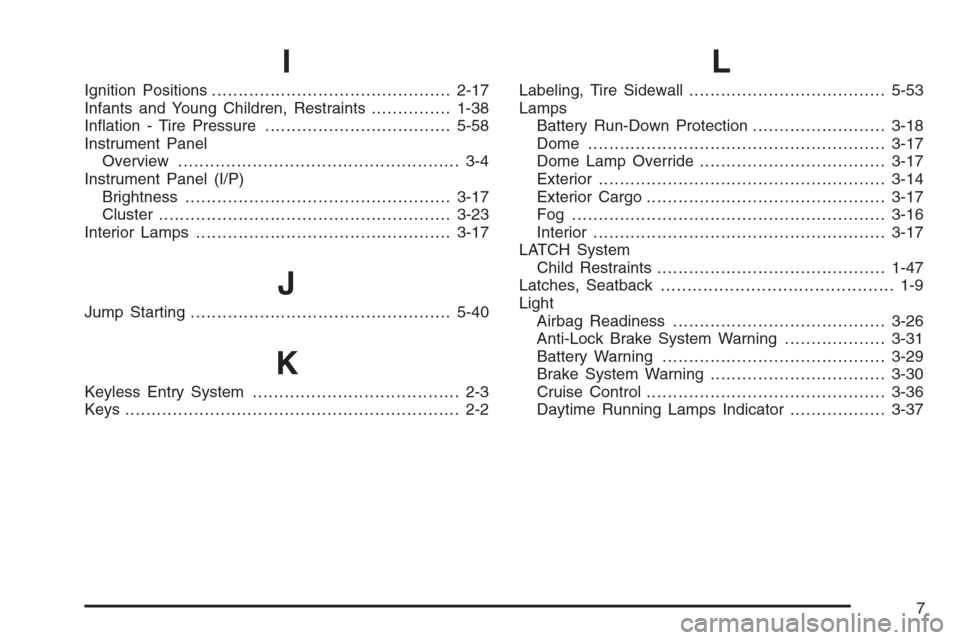
I
Ignition Positions.............................................2-17
Infants and Young Children, Restraints...............1-38
In�ation - Tire Pressure...................................5-58
Instrument Panel
Overview..................................................... 3-4
Instrument Panel (I/P)
Brightness..................................................3-17
Cluster.......................................................3-23
Interior Lamps................................................3-17
J
Jump Starting.................................................5-40
K
Keyless Entry System....................................... 2-3
Keys............................................................... 2-2
L
Labeling, Tire Sidewall.....................................5-53
Lamps
Battery Run-Down Protection.........................3-18
Dome ........................................................3-17
Dome Lamp Override...................................3-17
Exterior......................................................3-14
Exterior Cargo.............................................3-17
Fog ...........................................................3-16
Interior.......................................................3-17
LATCH System
Child Restraints...........................................1-47
Latches, Seatback............................................ 1-9
Light
Airbag Readiness........................................3-26
Anti-Lock Brake System Warning...................3-31
Battery Warning..........................................3-29
Brake System Warning.................................3-30
Cruise Control.............................................3-36
Daytime Running Lamps Indicator..................3-37
7
Page 432 of 434
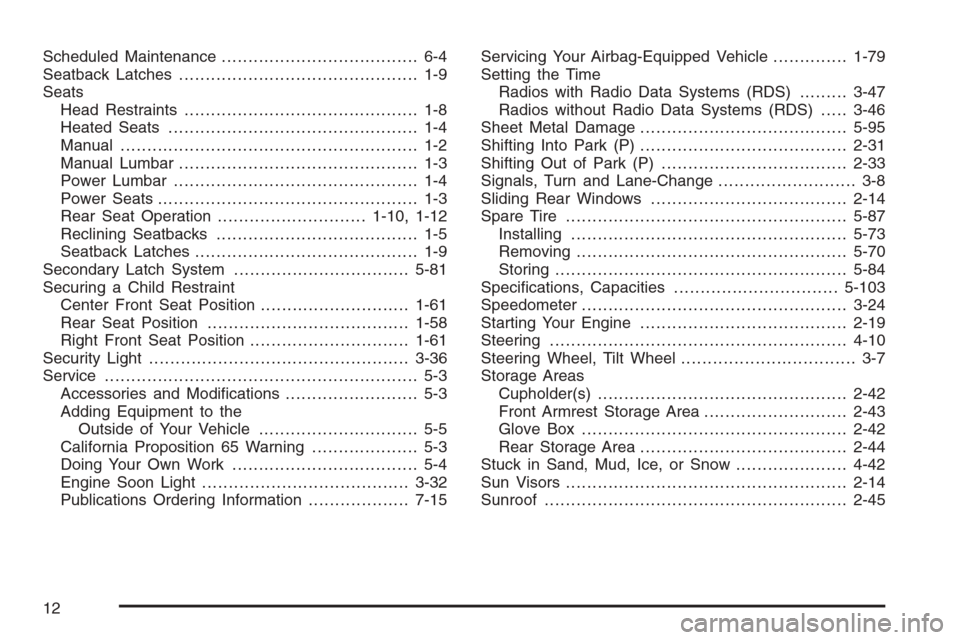
Scheduled Maintenance..................................... 6-4
Seatback Latches............................................. 1-9
Seats
Head Restraints............................................ 1-8
Heated Seats............................................... 1-4
Manual........................................................ 1-2
Manual Lumbar............................................. 1-3
Power Lumbar .............................................. 1-4
Power Seats................................................. 1-3
Rear Seat Operation............................1-10, 1-12
Reclining Seatbacks...................................... 1-5
Seatback Latches.......................................... 1-9
Secondary Latch System.................................5-81
Securing a Child Restraint
Center Front Seat Position............................1-61
Rear Seat Position......................................1-58
Right Front Seat Position..............................1-61
Security Light.................................................3-36
Service........................................................... 5-3
Accessories and Modi�cations......................... 5-3
Adding Equipment to the
Outside of Your Vehicle.............................. 5-5
California Proposition 65 Warning.................... 5-3
Doing Your Own Work................................... 5-4
Engine Soon Light.......................................3-32
Publications Ordering Information...................7-15Servicing Your Airbag-Equipped Vehicle..............1-79
Setting the Time
Radios with Radio Data Systems (RDS).........3-47
Radios without Radio Data Systems (RDS).....3-46
Sheet Metal Damage.......................................5-95
Shifting Into Park (P).......................................2-31
Shifting Out of Park (P)...................................2-33
Signals, Turn and Lane-Change.......................... 3-8
Sliding Rear Windows.....................................2-14
Spare Tire.....................................................5-87
Installing....................................................5-73
Removing...................................................5-70
Storing.......................................................5-84
Speci�cations, Capacities...............................5-103
Speedometer..................................................3-24
Starting Your Engine.......................................2-19
Steering........................................................4-10
Steering Wheel, Tilt Wheel................................. 3-7
Storage Areas
Cupholder(s)...............................................2-42
Front Armrest Storage Area...........................2-43
Glove Box..................................................2-42
Rear Storage Area.......................................2-44
Stuck in Sand, Mud, Ice, or Snow.....................4-42
Sun Visors.....................................................2-14
Sunroof.........................................................2-45
12